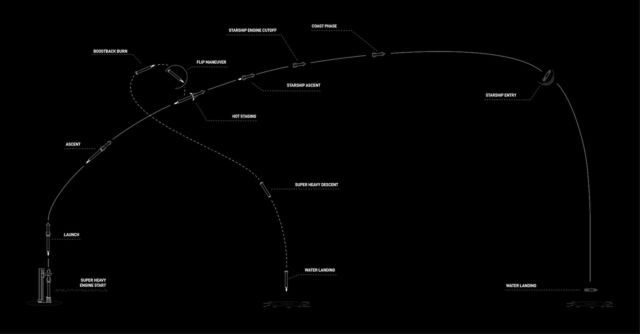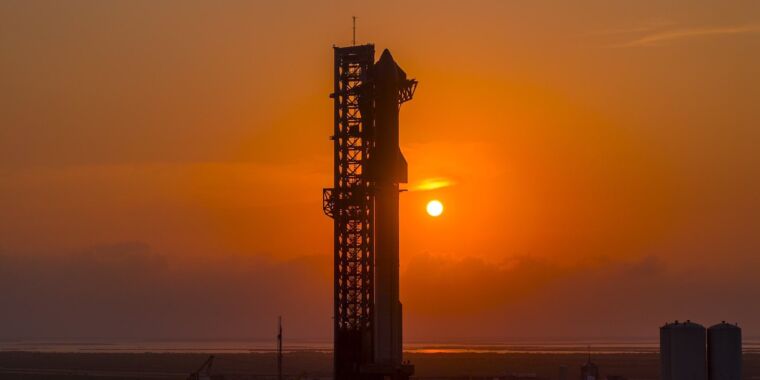SpaceX
The Federal Aviation Administration approved a commercial launch license for the fourth test flight of SpaceX's Starship rocket on Tuesday, and the launch is scheduled to take place from south Texas just after sunrise on Thursday.
“The Federal Aviation Administration has approved a licensing permit for SpaceX Starship Flight 4,” the agency said in a statement. “SpaceX met all safety and other licensing requirements for this test flight.”
Shortly after the Federal Aviation Administration announced the launch license, SpaceX confirmed plans to launch the fourth test flight of the world's largest rocket at 7:00 a.m. CST (12:00 UTC) on Thursday. The launch window lasts for two hours.
This flight follows three previous test missions, each progressively more successful, of the massive rocket developed privately by SpaceX. The last time the spacecraft flew on March 14, it completed an eight-and-a-half-minute ascent into space, but the ship was unable to maneuver itself as it hovered about 150 miles (250 km) above Earth. This controllability problem caused the missile to disintegrate during reentry.
On Thursday's flight, SpaceX officials expect the ascent portion of the test flight to be as successful as the launch in March. The goals this time will be to demonstrate the spacecraft's ability to survive extreme temperatures upon reentry, when temperatures peak at 2,600 degrees Fahrenheit (1,430 degrees Celsius) as the craft plunges into the atmosphere at more than 20 times the speed of sound.
SpaceX officials also hope to see the Super Heavy rocket guide itself toward a soft landing in the Gulf of Mexico just offshore from the company's launch site, known as Starbase, in Cameron County, Texas.
“The fourth flight test shifts our focus from reaching orbit to demonstrating the ability to return and reuse Starship and Super Heavy,” SpaceX wrote in a mission overview.
Last month, SpaceX completed a “wet rehearsal” at Starbase, where the launch team fully loaded the rocket with cryogenic methane and liquid oxygen fuel. Before the training countdown, SpaceX tested the rocket and vehicle at the launch site. Recently, technicians installed components of the missile's self-destruct system, which will be activated to detonate the missile if it veers off course.
Then, on Tuesday, SpaceX lowered the Starship's upper stage from the top of the Super Heavy booster, likely to make the final touches to the ship's heat shield, made up of 18,000 hexagonal ceramic tiles to protect its stainless steel hull during reentry. Ground teams are expected to hoist the ship, or upper stage, back onto the top of the booster sometime Wednesday, returning the rocket to its full height of 397 feet (121 meters) before the Thursday morning launch window.
TikTok: The fourth flight of the Starship spacecraft
If all goes according to plan, SpaceX's launch team will begin loading 10 million pounds of ultra-cold propellant into the rocket about 49 minutes before liftoff on Thursday. The methane and liquid oxygen will flow first into smaller tanks on the ship, then into larger tanks on the booster.
The rocket must be fully loaded about three minutes before launch, and after a series of automated checks, the computer controlling the countdown will give the command to light up the rocket's 33 Raptor engines. Three seconds later, the rocket will begin its vertical ascent from the launch pad, and its engines will be capable of producing more than 16 million pounds of thrust at full power.
Heading east from the Texas Gulf Coast, the rocket will exceed the speed of sound in about a minute, then begin shutting down its 33 main engines about 2 minutes and 41 seconds after liftoff. Then, just as the super-heavy rocket lifts off to begin its descent back to Earth, the Starship's six Raptor engines will ignite to continue propelling the top of the rocket into space. The Starship's engines are expected to burn to T+ 8 minutes and 23 seconds, accelerating the rocket to near-orbital speed with enough energy to fly a curved trajectory halfway around the world to the Indian Ocean.
All of this will be similar to the events of the last spacecraft launch in March. What is different in the flight plan this time is the attempts to direct the booster and return it to Earth. This is important for laying the groundwork for future flights, when SpaceX wants to bring the super-heavy booster — about the size of a Boeing 747 jumbo jet — to a landing at the launch pad. Eventually, SpaceX also intends to recover reusable spacecraft at Starbase or other spaceports.

SpaceX
And based on the results of the test flight in March, SpaceX still has a lot to prove in these areas. On that flight, the engines on the Super Heavy rocket were unable to complete all the burns required to guide the rocket toward the landing zone in the Gulf of Mexico. The booster lost control when it fell toward the ocean.
Engineers tracked down a blockage failure in the filter through which liquid oxygen flows to the Raptor's engines. It is worth noting that a similar problem occurred on the second test flight of the Starship vehicle last November. The Super Heavy rocket awaiting launch on Thursday has additional hardware to improve its propellant filtration capabilities, according to SpaceX. The company also implemented “operational changes” to the booster for the upcoming test flight, including eliminating the Super Heavy's staging ring, which is located between the booster and the ship during launch, to reduce the mass of the rocket during landing.
SpaceX has a lot of experience returning its fleet of Falcon 9 boosters. The company now boasts a string of more than 240 consecutive successful rocket landings, so it's reasonable to expect SpaceX to overcome the challenge of recovering the much larger Super Heavy booster.

“Extreme travel lover. Bacon fanatic. Troublemaker. Introvert. Passionate music fanatic.”







More Stories
A fossilized creature may explain a puzzling drawing on a rock wall.
MrBeast Sued Over ‘Unsafe Environment’ on Upcoming Amazon Reality Show | US TV
Watch comets Lemmon and SWAN approach Earth today